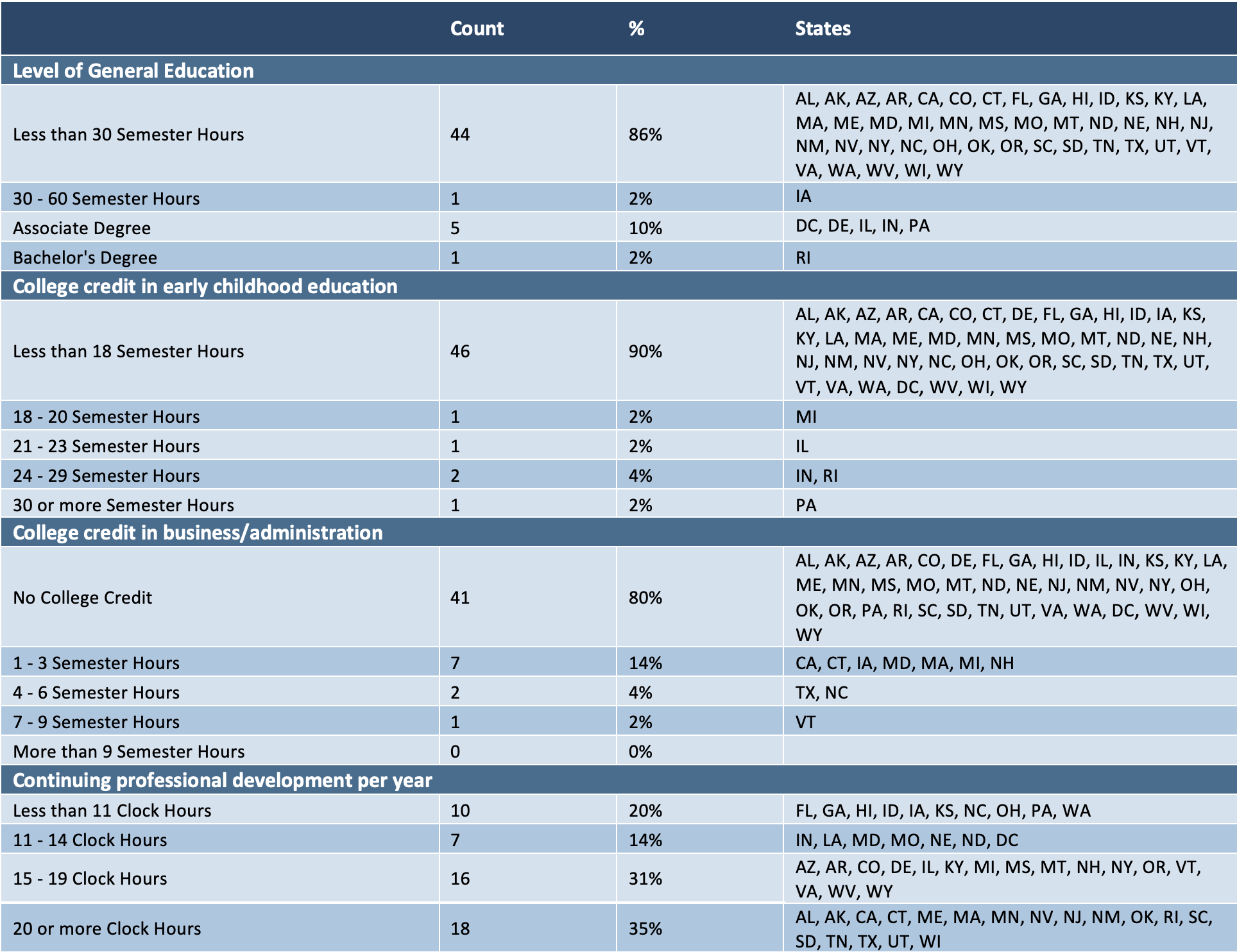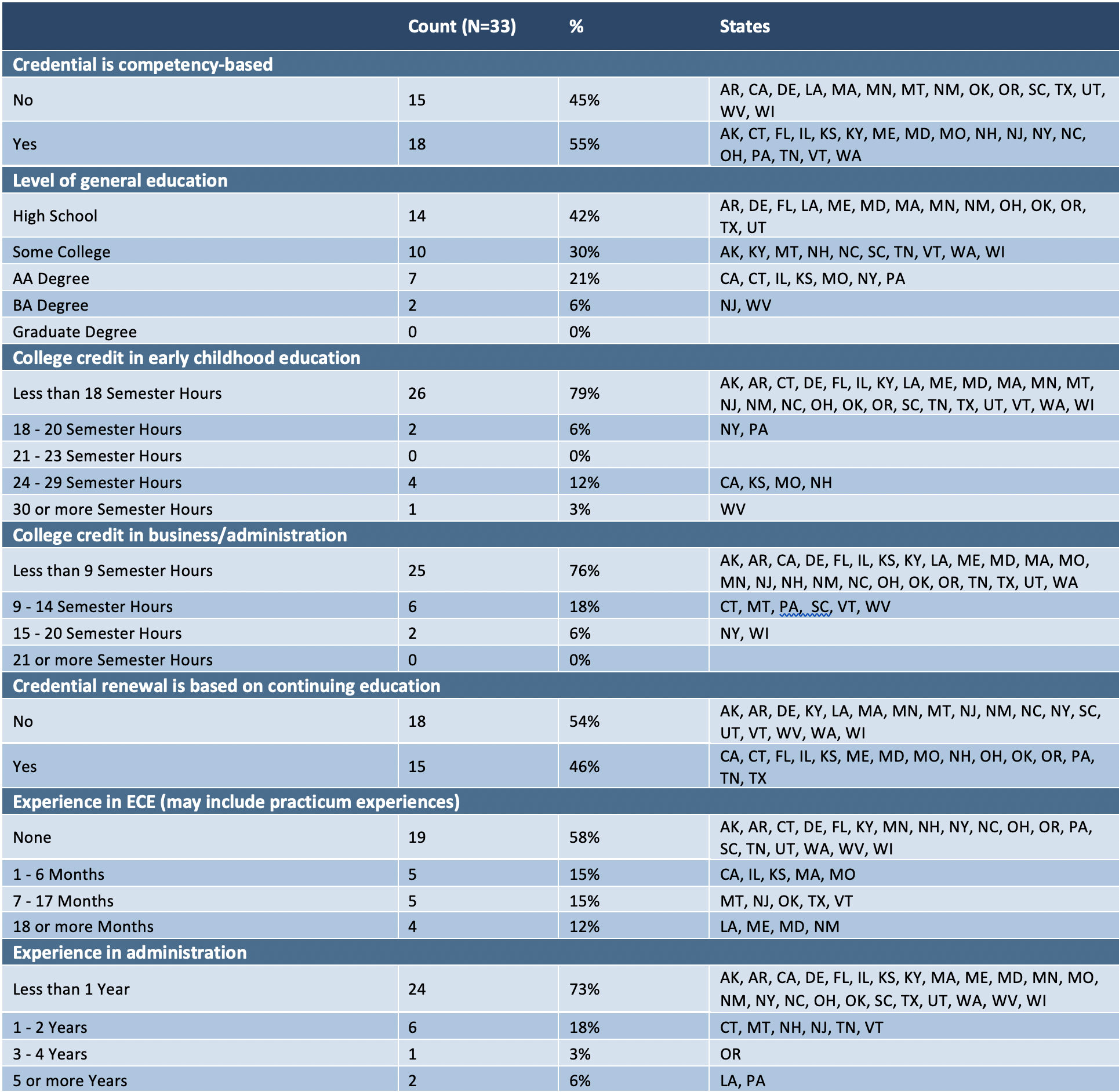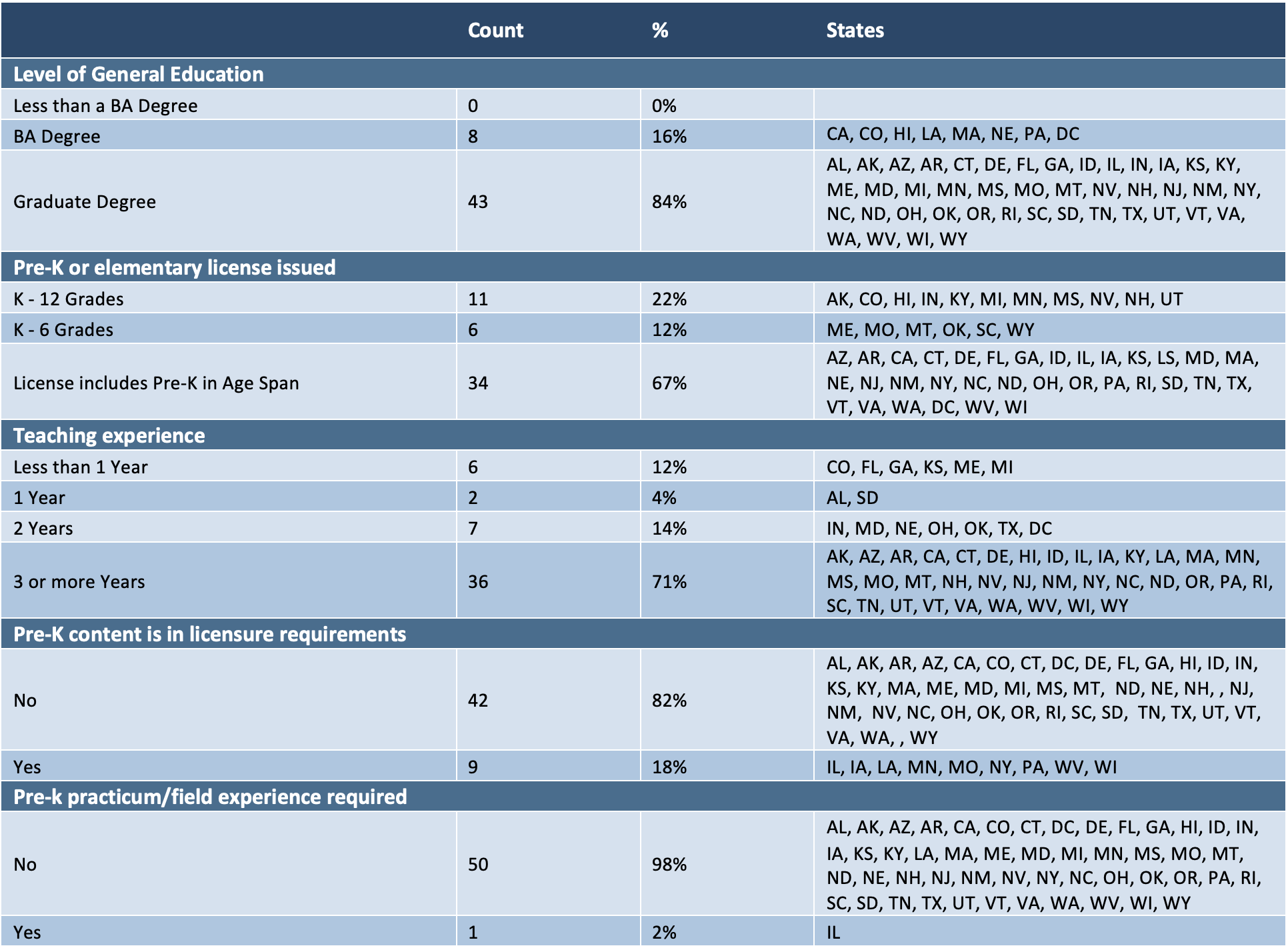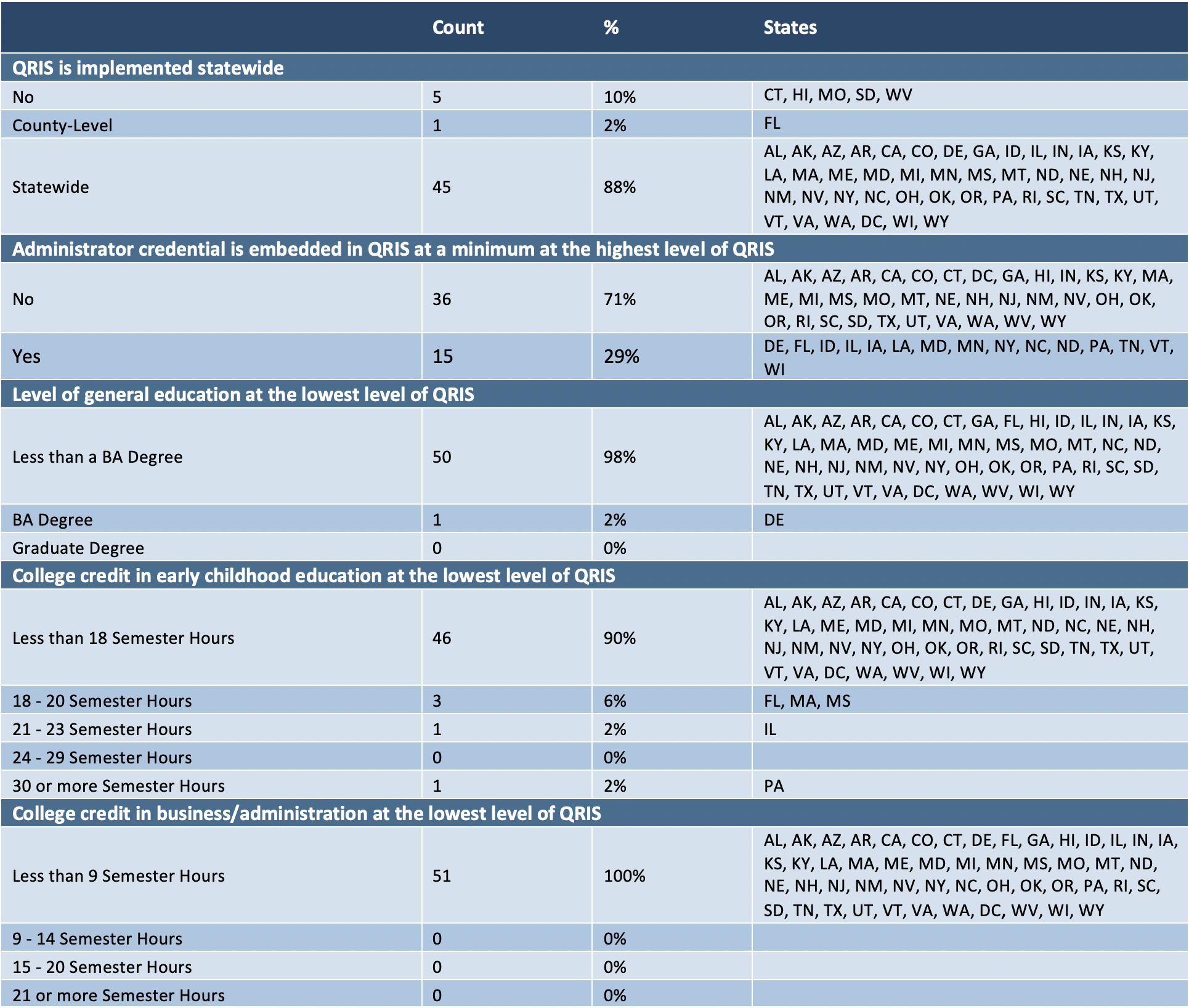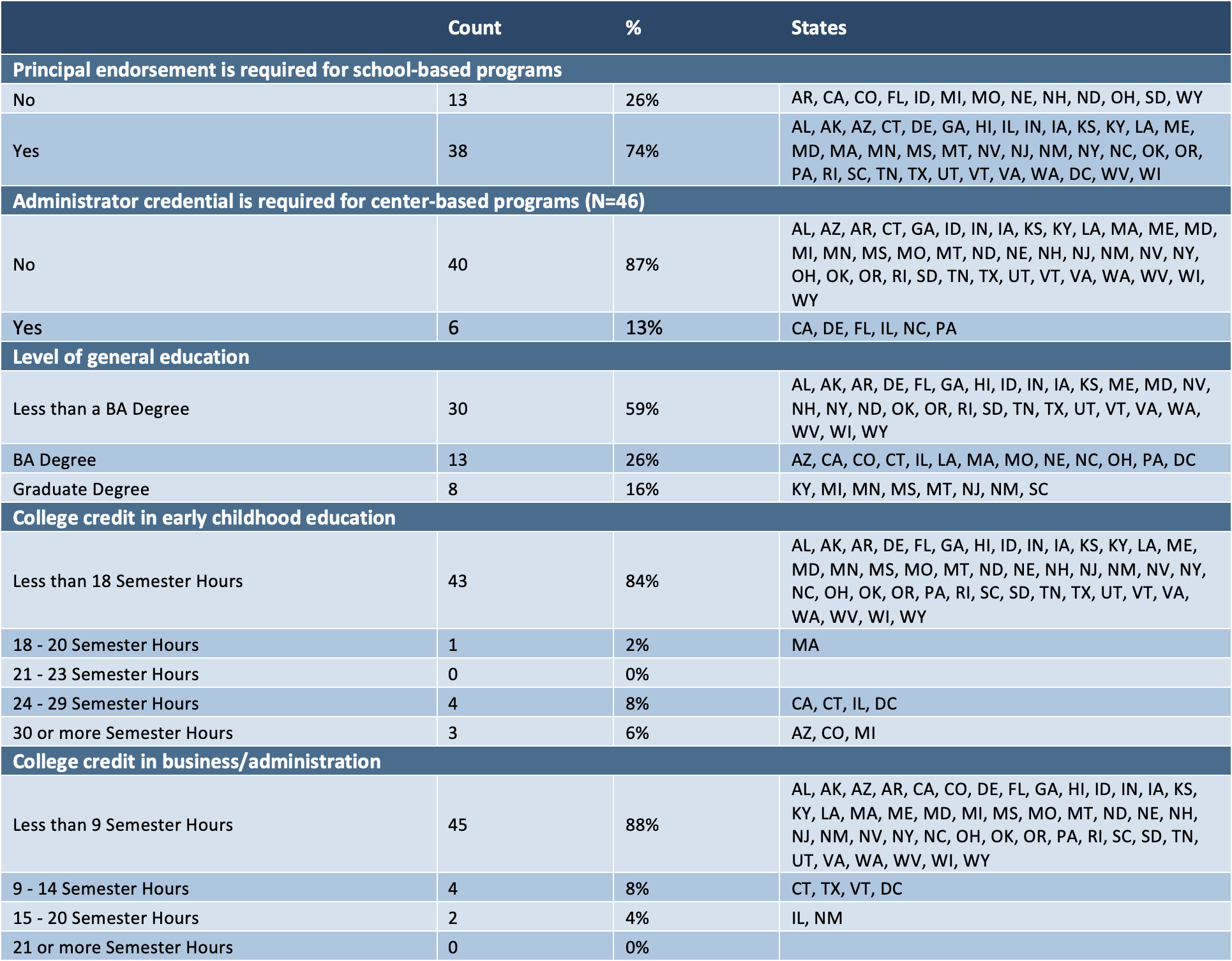Nationally, early childhood education leaders are working to define the profession and establish a unified professional framework for the workforce. The “North Star” vision for all lead early educators is a minimum of a bachelor’s degree in early childhood education (Friedman-Krauss, Barnett, Weisenfeld, Kasmin, DiCrecchio, & Horowitz, 2018). While this offers clarity to the field regarding teachers and pedagogical leaders, it does not address issues regarding the requisite professional preparation and continuing education of program administrators responsible for the administrative leadership of early childhood programs.
Consideration of early childhood program administrators has been noticeably absent from much of the recent discussion about the workforce crisis, including the preparation, ongoing support, and compensation needed to stabilize the profession. Bearing in mind the impact on organizational climate, program development and sustainability, as well as the influence of directors, family child care professionals, and school principals on teaching and learning, it is reasonable that site-based program leaders should be factored into a reimagined and transformed workforce. Minimally, general education requirements should include a bachelor’s degree, specialized education and training in early childhood education and child development, and specialized education and training in program administration. Requisite qualifications for early childhood program administrators should at least match, if not exceed, those of early childhood teachers.
EARLY CHILDHOOD LEADERSHIP GAP
There is a lack of consistent policies and supports for improving the qualifications and competencies of those who lead early childhood programs, resulting in a leadership gap. The gap is most evident between early childhood center administrators and elementary school principals serving Pre-K children (Abel, Talan, Pollitt, and Bornfreund, 2016; Lieberman, 2017). In addition, with recent advances in the requisite qualifications for publicly-funded early childhood teachers, a qualifications gap is beginning to emerge between teachers and center-based administrators. It is essential that the qualifications for program administrators keep pace with those of teachers and that program administrators also receive specialized education and training in leadership and management.
Four years ago, the McCormick Center for Early Childhood Leadership published a report on the status of early childhood leadership in all fifty states and the District of Columbia. The report included information about five policy levers that identify the minimal qualifications for administrators in child care licensing standards, state administrator credentials, principal licensure, quality rating and improvement systems (QRIS), and state-funded Pre-K programs. Closing the Leadership Gap: 2017 Status Report on Early Childhood Program Leadership in the United States (Abel, Talan, and Newkirk, 2017) highlighted the extent of the leadership gap and reported on key policy differences that brought the problem center-stage.
The current 2021 study provides an updated report on the status of early childhood program leadership in the United States. Specifically, this study looks at whether there have been any changes to states’ ratings on the five policy levers indicating a more unified professional framework for site-based program leaders since the initial study was conducted in 2017.
HOW DATA WAS COLLECTED
The research team studied documents available electronically on the websites of state legislatures, administrator credentialing programs, QRIS initiatives, departments of education, human services, and early childhood development and learning, as well as the QRIS Compendium and the New America Pre-K Policy Scan. The data collected from these sources were used to update each of the five policy lever rubrics for each state on the L.E.A.D. Early Childhood Clearinghouse (McCormickCenter.nl.edu). Based on these updated rubrics, each state was given an overall policy rubrics score which was examined for changes from 2017 to 2021.
THAT WAS THEN (2017)
National Profile
While the early childhood education profession was moving toward acceptance of the BA in early childhood education as the standard for lead teachers, there was no agreement about early childhood program leaders’ requisite competencies and education. Instead, federal and state regulatory systems had created a wide array of standards for individuals leading programs for children, birth through age eight. Professional preparation standards for elementary school principals were consistently more robust than those for center- or home-based program leaders. While the vast majority of states required elementary school principals to have a graduate degree in education, only New Jersey required a licensed center director to have a bachelor’s degree. However, this requirement applied only if the program served more than thirty children. Advancements in standards for administrators of child care programs, primarily seen in voluntary state QRIS and state-funded Pre-K, had not led to substantial improvements in the basic qualifications of early childhood program administrators.
In 2017, no state scored higher than six (out of ten) on their state-specific, overall policy levers rubric. Three states—California, Illinois, and Pennsylvania—achieved the highest overall policy levers score (range of 5-7). Table 1 provides the scoring rubric used to determine each state’s overall policy levers score.
Policy Levers
States’ policies regarding the professional requirements for early childhood program administrators were assessed on five policy levers:
- Administrator Qualifications in Child Care Licensing Standards
- Administrator Credential
- Principal Licensure
- Administrator Qualifications in QRIS
- Administrator Qualifications in State Pre-K Programs
The five policy levers were derived from the recommendations of the 2015 National Academy of Medicine report, Transforming the Workforce for Children Birth through Age 8 (Institute of Medicine and National Research Council, 2015). This report called for a unifying foundation for all lead educators—inclusive of center directors, principals, and family child care professionals—having a minimum of a bachelor’s degree with content knowledge and competency in child development/early childhood education. Additional competencies, depending on role, were also required. The five policy levers and the scoring rubrics addressed the need for early childhood program leaders across sectors to have a BA degree and competencies in both child development/early childhood education and program administration. The goal of reporting each state’s overall policy levers score was to encourage thought leaders, policymakers, and advocates to tear down the silos and take a cross-sector, systems approach to improving the qualifications, competencies, and ongoing professional development of early childhood program leaders.
Administrator Qualifications in Child Care Licensing Standards (2017)
- No state required a bachelor’s degree of directors in its child care licensing standards for all programs regardless of size.
- Only New Jersey required a bachelor’s degree for directors of licensed child care programs serving more than thirty children.
- Only five states (Delaware, Illinois, Indiana, Pennsylvania, and Rhode Island) and the District of Columbia required an associate degree (or its equivalent number of college credits) for newly-hired directors.
Administrator Credential (2017)
- There were voluntary early childhood administrator credentials offered in thirty states.
- Only two states required a minimum of a bachelor’s degree (New Jersey and West Virginia).
- Only six states required a minimum of an associate degree (California, Connecticut, Illinois, Kansas, Missouri, and Pennsylvania).
Principal Licensure (2017)
- Forty states required a graduate degree for school principals.
- Only nine states (Illinois, Iowa, Louisiana, Minnesota, Missouri, New York, Pennsylvania, West Virginia, and Wisconsin) included Pre-K content in their licensure requirements.
- Only Illinois included a Pre-K practicum or field experience in licensure requirements.
Administrator Qualifications in QRIS (2017)
- In sixteen states, a bachelor’s degree was required of early childhood administrators at the highest level of their QRIS.
- Ten states (Arizona, California, Illinois, Ohio, Minnesota, Nevada, North Carolina, South Carolina, Virginia, and Washington) required twenty-one or more college credits in early childhood education or child development college coursework at the highest level of QRIS.
- Only three states (California, New York, and Hawaii) included any college credit in business or administration at the highest level of QRIS.
Administrator Qualifications in State Pre-K Programs (2017)
- Sixteen states and the District of Columbia required a bachelor’s degree or higher of administrators in state-funded Pre-K programs.
- Thirty-eight states and the District of Columbia required administrators of state-funded Pre-K programs to hold a principal license in school-based programs.
- Only five states (California, Florida, Illinois, North Carolina, and Pennsylvania) required administrators of center-based Pre-K programs to have earned an administrator credential.
This is now (2021)
National Profile
Today there is consensus on a unifying framework for the early childhood profession. The Unifying Framework for the Early Childhood Education Profession (PowerToTheProfession.org) clearly defines the standards, qualifications, roles, compensation, and supports for members of the early childhood profession working with children from birth through age eight. While this unifying framework is inclusive of instructional or pedagogical leaders, it does not encompass the requisite competencies, education, compensation, and supports for early childhood program administrators—those with overall responsibility for leading early childhood education and care programs situated in child care centers, family child care homes, and elementary schools. Professional preparation standards for elementary school principals continue to be far more robust than those for center- or home-based program leaders. There is still only one state, New Jersey, that requires a licensed center director to have a bachelor’s degree (if the program serves more than thirty children). One emerging trend in child care licensing is the bifurcation of the administrative role into two required positions (depending on the number of children served), one responsible for pedagogical leadership and one for administrative leadership (Delaware, New Jersey, and Rhode Island).
In 2021, only Illinois, scored a seven (out of ten) on the state-specific, overall policy levers rubric. Only two states—Illinois and Pennsylvania—scored between five and seven on their overall policy levers rubric. While the national picture shows little variation over the past four years, zooming in to specific benchmarks within each state’s policy rubrics reveals small changes in required standards or policies, suggesting subtle movement toward increased professional qualifications and supports for early childhood program leaders. Tables 2-6 provide counts, percentages, and lists of states that meet each of the benchmarks found within the five policy lever rubrics. Below are some highlights from the 2021 policy scan.
Administrator Qualifications in Child Care Licensing Standards (2021)
- There is still only one state (New Jersey) that requires a bachelor’s degree for directors of licensed child care centers, but this requirement applies only to centers serving more than thirty children.
- Rhode Island requires a bachelor’s degree for the pedagogical leader (called a Head Teacher) for all licensed child care centers, in addition to a Director responsible for administrative leadership. In small programs, these roles may be filled by the same person.
- Four states (Delaware, Illinois, Indiana, and Pennsylvania) and the District of Columbia require an associate degree (or the equivalent number of college credits) for newly-hired directors in their child care licensing standards.
- Only Pennsylvania requires thirty or more college credits in early childhood education or child development; Illinois, Indiana, and Rhode Island require at least twenty-one college credits in early childhood education or child development.
- Only Vermont requires at least seven college credits in business or administration.
Administrator Credential (2021)
- Thirty-three states offer an early childhood administrator credential (a gain of three states, New Mexico, Texas, and Vermont, since 2017); the majority (55%) of administrator credentials are competency-based.
- Twenty-one states recognize the Aim4Excellence™ National Director Credential, and six states recognize the National Administrator Credential in their state’s Early Childhood Professional Development System.
- Two states require a minimum of a bachelor’s degree (New Jersey, and West Virginia).
- Seven states require a minimum of an associate degree (California, Connecticut, Illinois, Kansas, Missouri, New York, and Pennsylvania), a gain of one state since 2017.
Principal Licensure (2021)
- Forty-three states require a graduate degree for their school leaders, a gain of three states.
- Thirty-six states require three or more years of teaching experience for school leaders.
- Only nine states (Illinois, Iowa, Louisiana, Minnesota, Missouri, New York, Pennsylvania, West Virginia, and Wisconsin) include Pre-K content in their licensure requirements.
- Only Illinois requires a Pre-K practicum or field experience in licensure requirements.
Administrator Qualifications in QRIS (2021)
- In fifteen states, an administrator credential is embedded in QRIS at one or more levels.
- Only Delaware requires a bachelor’s degree at the lowest level of QRIS.
- Only Illinois requires a minimum of twenty-one semester hours of college credit in early childhood education or child development at the lowest level of QRIS.
- No state requires a minimum of nine semester hours of college credit in business or administration at the lowest level of QRIS.
Administrator Qualifications in State Pre-K Programs (2021)
- Twenty states and the District of Columbia (four more than in 2017) required a bachelor’s degree or higher of administrators in state-supported Pre-K programs.
- The number of states (thirty-eight) that require administrators of state-funded Pre-K programs to hold a principal license or endorsement in school-based programs remains the same as in 2017.
- Six states (California, Delaware, Florida, Illinois, North Carolina, and Pennsylvania) require administrators of center-based Pre-K programs to have earned an administrator credential—a gain of one state since 2017.
- Only seven states (Arizona, California, Colorado, Connecticut, Illinois, Massachusetts, Michigan) and the District of Columbia require 18 or more college credits in early childhood education or child development.
- Only five states (Connecticut, Illinois, New Mexico, Texas, Vermont) and the District of Columbia require nine or more college credits in business or administration.
DISCUSSION
Taking a macro view, the early childhood program leadership gap is just as large in 2021 as it was in 2017. The overall policy levers score went up in six states and down in seven states. In four years, no state achieved an overall policy levers score in the top quartile (range of 8 – 10). Zooming in to the micro view, however, there were small advances toward a more unified professional framework for program leaders working across sectors. In child care licensing, administrative intensity is beginning to be addressed. Additional administrators (variously called Education Coordinator, Head Teacher, or Group Teacher) are required based on the number of children served in the licensed child care program. This position, not to be counted in teacher: child ratios, provides pedagogical leadership and has the same or more stringent educational requirements as the Director. The additional administrative role, regardless of title, creates a “leadership bench” to ensure adequate capacity to carry out essential leadership functions. Momentum in administrator credentialing also appears to be growing: three more states offer a voluntary administrator credential (New Mexico, Texas, and Utah), one more state requires a minimum of an associate degree (New York), and the majority of state administrator credentials are now competency-based.
RECOMMENDATIONS FOR POLICY
Three policy recommendations are emerging from the updated L.E.A.D. Early Childhood Clearinghouse data. First, there is a pressing need for a unifying foundation of administrative qualifications and competencies reflecting a whole leadership approach across sectors. A competent early childhood program leader working in a school, center, or licensed home needs core knowledge and skills in child development, early childhood pedagogy, leadership essentials, and program administration. Second, the silos of program standards by sector for early childhood administrators can best be eliminated by considering the five policy levers together. Third, attention to leadership capacity—multiple and differentiated leadership positions based on consistent criteria—will need to be addressed in future policy scans of early childhood program leadership.
This brief summarizes changes in state policies regarding program leadership since the findings from the cross-sector policy scan were first disseminated in 2017.
If you find errors in how your state is represented in the updated policy scan, we welcome your input! Please contact teri.talan@nl.edu to provide additional information about your state’s policies concerning the professional preparation and ongoing support of early childhood education and care (ECEC) program leaders working in schools, centers, and homes. Our team will keep updating the L.E.A.D. Early Childhood Clearinghouse database with new information from your responses. Information you provide will greatly aid our efforts to track progress toward the “North Star vision” of a unifying professional framework for ECEC program leaders.
Table 1. Policy Lever Rubric
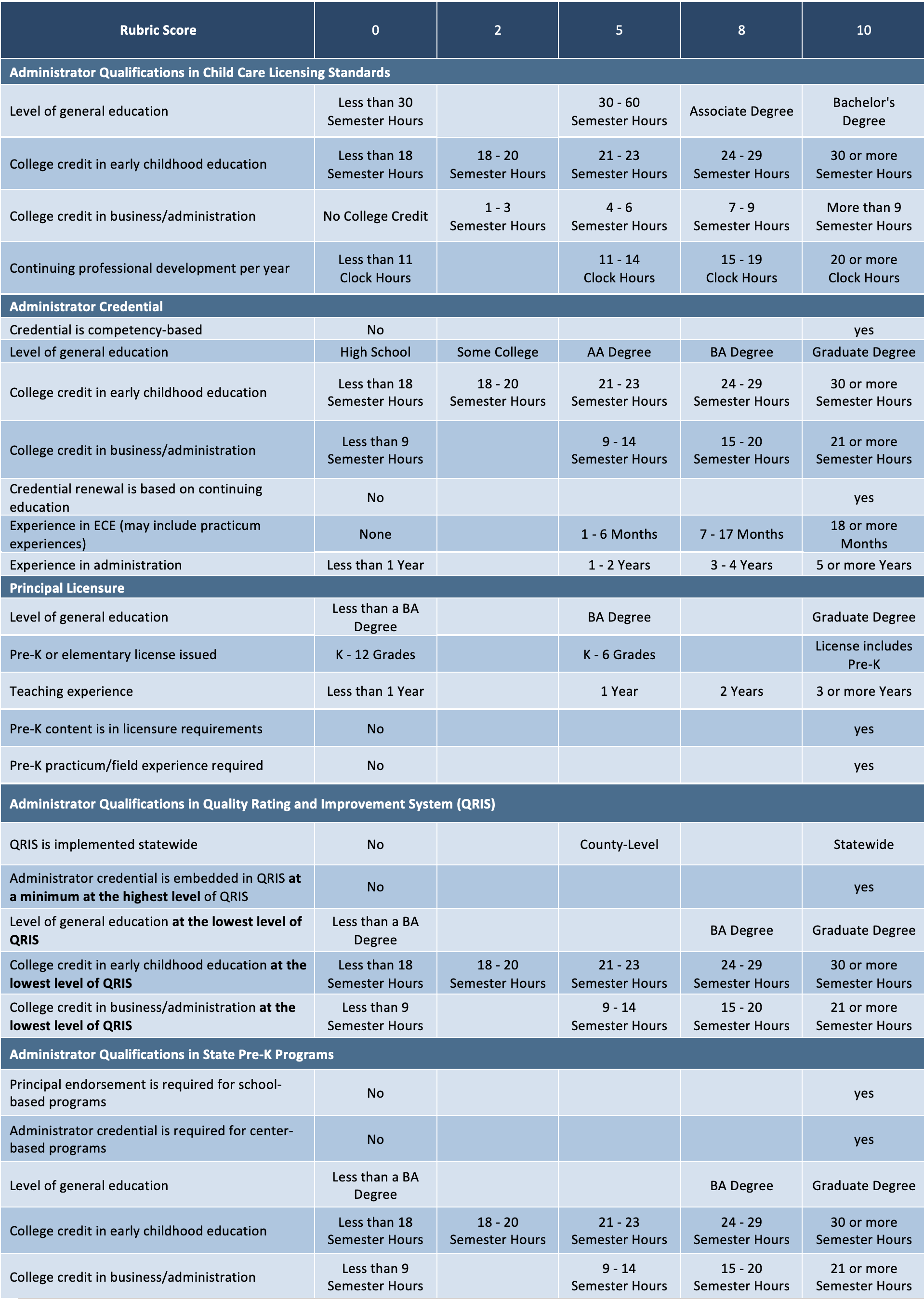
Table 2. Administrator Qualifications in Child Care Licensing Standards (2021)
